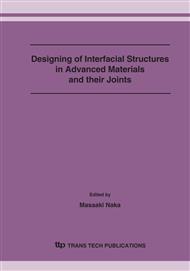p.97
p.103
p.109
p.115
p.123
p.129
p.135
p.141
p.147
Interfacial Residual Stresses in Semiconductor Devices Measured on the Nano-Scale by Cathodoluminescence Piezospectroscopy
Abstract:
Electron-stimulated (cathodo)luminescence spectroscopy is quantitatively used for obtaining information about the residual stress fields piled up in semiconductor materials and devices during manufacturing. This additional micromechanical output can be added to the microscopic structural/chemical information available in the scanning electron microscope (SEM) by other conventional techniques. Independent of the physical mechanisms behind the luminescence emission, the spectral position of selected cathodoluminescence (CL) bands, observed in both crystalline and glassy materials, is shown to possess high stress sensitivity and thus suitability as a sensor for residual stress assessments. In this paper, we first quantitatively characterize the stress dependence of typical CL bands observed in ceramic and glassy semiconductor materials. Then, based on this knowledge, applications are shown of two-dimensional residual stress mapping on the nano-meter scale in electronic devices involving atomically sharp interfaces, according to an optimized automatic procedure performed into a field-emission gun (FEG-)SEM.
Info:
Periodical:
Pages:
123-128
Citation:
Online since:
September 2007
Authors:
Price:
Сopyright:
© 2007 Trans Tech Publications Ltd. All Rights Reserved
Share:
Citation:


